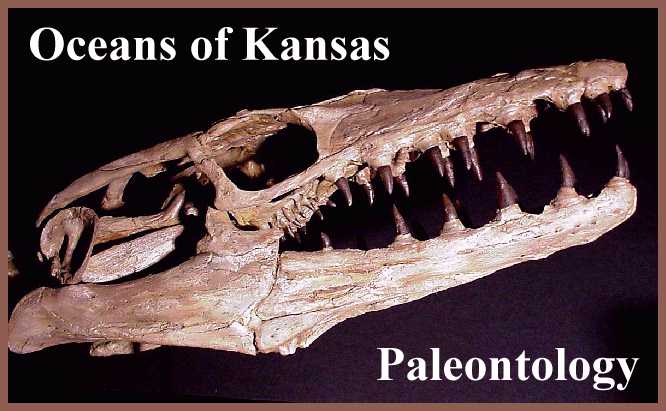 |
OCEANS OF KANSAS PALEONTOLOGY Fossils from the Late Cretaceous Western Interior Sea Copyright © 1996-2006 by Mike Everhart On the Web since December, 1996 Last updated 03/09/2010
LEFT: The reconstructed skull of Platecarpus planifrons (FHSM VP-13910) |
 |
Welcome to the Oceans of Kansas Paleontology web page. My name is Mike Everhart and I am your host on a virtual journey more than 85 million years "back in time" to observe some of the many strange and wonderful creatures that lived in the oceans of the Earth during the final stages of the Age of Dinosaurs. (More info here) I have collected fossils from the Smoky Hill Chalk of western Kansas for the last thirty-plus years and have been an Adjunct Curator of Paleontology at the Sternberg Museum of Natural History in Hays, Kansas since 1998. I am the Past President of the Kansas Academy of Science, and now am also the editor of the Transactions of the Kansas Academy of Science. I have conducted a Paleontology Symposium at the past six annual meetings of the KAS and am looking forward to the 7th paleo-symposium on April 8, 2006 at Wichita State University, Wichita, Kansas. | 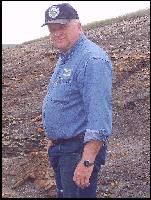 |
| My interests are primarily in marine reptiles, and especially mosasaurs and plesiosaurs. More recently, I have become interested in Kansas sharks from the early Permian through the Late Cretaceous. In that regard, in 1996 I created Oceans of Kansas Paleontology as an educational site to provide factual information about the animals that lived in and over the ancient ocean that once covered Kansas and much of the central portion of North America. I'm looking forward to celebrating 10 years on the Internet later this year (December)... stay tuned. |
2005 PUBLICATIONS Everhart, M. J. 2005. Oceans of Kansas - A Natural History of the Western Interior Sea. Indiana University Press, 322 pp. Everhart,
M. J. 2005. Bite marks on an elasmosaur (Sauropterygia; Plesiosauria) paddle from the
Niobrara Chalk (Upper Cretaceous) as probable evidence of feeding by the lamniform shark, Cretoxyrhina
mantelli. PalArch, Vertebrate paleontology 2(2): 14-24. Everhart,
M. J. 2005. Rapid evolution, diversification and distribution of
mosasaurs (Reptilia; Squamata) prior to the K-T Boundary. Tate 2005 11th Annual
Symposium in Paleontology and Geology, Casper, WY, p. 16-27 (not peer-reviewed). Everhart, M. J. and S. A. Hamm. 2005. A
new nodosaur specimen (Dinosauria: Nodosauridae) from the Smoky Hill Chalk (Upper
Cretaceous) of western Kansas. Kansas Academy of Science, Transactions 108(1/2): 15-21. Schumacher, B. A.
and M. J. Everhart. 2005. A stratigraphic and taxonomic review of plesiosaurs from
the old “Fort Benton Group” of central Kansas: A new assessment of old records. Paludicola 5(2):33-54. Everhart, M. J. 2005. Probable plesiosaur gastroliths from the basal Kiowa Shale (Early Cretaceous) of Kiowa County, Kansas. Kansas Academy of Science, Transactions 108 (3/4): 109-115. Everhart, M. J. 2005. Earliest record
of the genus Tylosaurus (Squamata; Mosasauridae) from the Fort Hays Limestone
(Lower Coniacian) of western Kansas. Transactions 108 (3/4): 149-155. Everhart, M. J. 2005. Elasmosaurid remains from the Pierre Shale (Upper Cretaceous) of
western Kansas. Possible missing elements of the type specimen of Elasmosaurus
platyurus Cope 1868? PalArch 4(3): 19-32. (Downloadable
from PalArch) Everhart, M. J. 2005b. Tylosaurus
kansasensis, a new species of tylosaurine (Squamata: Mosasauridae) from
the Niobrara Chalk of western Kansas, U.S.A. Netherlands Journal of Geosciences / Geologie
en Mijnbouw, 84(3), p. 231-240. Everhart, M. J. 2005. New stratigraphic records (Albian-Coniacian) of the guitarfish, Rhinobatos incertus (Chondrichthyes; Rajiformes), from the Cretaceous of central and western Kansas. Journal of Vertebrate Paleontology, 25(Supplement to 3): 55A. |
Oceans of Kansas is NOT about dinosaurs. Although the type specimen of Niobrarasaurus coleii was found in Kansas, this web site has very little information about dinosaurs. I do recommend some excellent dinosaur sites on the Oceans of Kansas Links page. For more information about the origin of mosasaur and plesiosaur names, go to Ben Creisler's Translation and Pronunciation Guide, a recent addition to the The Dinosauria On-Line Dinosaur Omnipedia. John Damuth's Bibliography of Fossil Vertebrates (BFV) is HERE. Click here for the most current view on the relationships of American mosasaurs. Also go HERE for a more detailed cladogram on Mikko Haaramo's Phylogeny Archive webpage.
For a free, downloadable copy (.pdf file) of Samuel Williston's (1914) excellent book: Water Reptiles of the Past and Present, CLICK HERE. For a fictional story about the daily life of a mosasaur, CLICK HERE. If you are interested in fossil insects, visit Roy Beckemeyer's "Winds of Kansas" webpage.
| My handy paleo-reference page | Search with Google | Search with Altavista |
| If you would like to learn more about paleontology in Kansas, you might consider joining the Kansas Academy of Science, It's inexpensive ($25 per year) and we have a variety of paleontology papers in the process of being published. Click here for an updated list of KAS publications on paleontology. |  |
THE SEVENTH ANNUAL PALEONTOLOGY SYMPOSIUM |
Click here for a brief history of the Kansas Academy of Science |
Systematics and morphology of American mosasaurs by Dale Russell "The best publication about mosasaurs" |
The Yale Peabody Museum Publications Office is pleased to announce
that the 1967 monograph, "Systematics and Morphology of American Mosasaurs"
by Dale Russell, Peabody Museum of Natural History, Yale University, Bulletin 23, is now
available as a facsimile reprint through the Yale Peabody Museum web site. The museum regularly receives requests for this title, which is the first of several of out-of-print publications that will be made available to the worldwide academic community through Yale's print-on-demand service. (Go to the Publications link at http://www.peabody.yale.edu). |
| QUICK SITE INDEX | Smoky Hill Chalk Field Guides: Invertebrates; Fish; Marine Reptiles; Pteranodons, Dinosaurs and Birds; Other |
| USE "PICO SEARCH" TO FIND ANY WORD OR PHRASE ON THE OCEANS OF KANSAS WEBSITE........ | ...OR USE THE GUIDE BELOW FOR SOME OF THE OCEANS OF KANSAS PALEONTOLOGY PAGES - JUST CLICK! |
| So you want to be a Paleontologist???? Check out this advice from the Dinosaur Mailing List |
| Would you like to hunt fossils in the Smoky Hill Chalk? Contact the Keystone Gallery for more information! |
![]() Oceans of Kansas
webpages (mostly about sharks) translated into French by Jean-Michel Benoit
Oceans of Kansas
webpages (mostly about sharks) translated into French by Jean-Michel Benoit ![]()
| Be warned that Oceans of Kansas Paleontology is a very LARGE and constantly changing web site. It has more than a hundred and fifty sub-pages, with hundreds of pictures of fossils and paleo-life art, and lots of other interesting information that is found no where else on the Internet or even in reference books. From time to time as new material is added, it will be listed below: |
| TABLE OF CONTENTS | WHAT'S NEW AT OCEANS OF KANSAS? | OOK LINKS |
![]() 12/05/05 Dr. Theophilus Turner and the discovery of Elasmosaurus
platyurus: The rest of the story and maybe the rest of the specimen?
12/05/05 Dr. Theophilus Turner and the discovery of Elasmosaurus
platyurus: The rest of the story and maybe the rest of the specimen?
![]() 12/03/05 Rapid evolution, diversification and distribution of
mosasaurs (Reptilia; Squamata) prior to the K-T Boundary - New mosasaur webpage
12/03/05 Rapid evolution, diversification and distribution of
mosasaurs (Reptilia; Squamata) prior to the K-T Boundary - New mosasaur webpage
![]() 11/20/05
An amateur collection: Ten-year-old Loren Lederhos
collected sharks teeth from the gravel around his home in Gorham, Kansas in 1940.
11/20/05
An amateur collection: Ten-year-old Loren Lederhos
collected sharks teeth from the gravel around his home in Gorham, Kansas in 1940.
![]() 10/26/05
Who first described a plesiosaur as a "snake
drawn through the shell of a turtle? ... Help solve this paleo-mystery
10/26/05
Who first described a plesiosaur as a "snake
drawn through the shell of a turtle? ... Help solve this paleo-mystery
![]() 06/19/05 Newly discovered remains of a hadrosaur dinosaur in Kansas.
Only the sixth specimen discovered in the Smoky Hill Chalk in over 130 years!
06/19/05 Newly discovered remains of a hadrosaur dinosaur in Kansas.
Only the sixth specimen discovered in the Smoky Hill Chalk in over 130 years!
![]() 02/06/05 Prognathodon in Kansas? Nothing new. In fact, Prognathodon
crassartus (Cope 1872) was one of the first mosasaurs discovered Kansas!
02/06/05 Prognathodon in Kansas? Nothing new. In fact, Prognathodon
crassartus (Cope 1872) was one of the first mosasaurs discovered Kansas!
12/03/04 The First Great Roof (Protostega gigas) and A Kansas Mosasaur - Two recently re-discovered papers by Charles H. Sternberg.
11/18/04 Elasmosaurus, mosasaurs and other Cretaceous marine fossils - at the NEW Rocky Mountain Dinosaur Resource Center.
10/13/04 Charles H. Sternberg - Discoveries of a Kansas fossil hunter.
10/06/04 Kansas Plesiosaurs - A chronology of Cretaceous plesiosaurs from Kansas.
09/26/04 Mosasaurs ate plesiosaurs! - A large Tylosaurus proriger found in western Kansas had a plesiosaur as a last meal
09/26/04 The Smoky Hill Chalk - A photographic tour of the Smoky Hill Chalk of western Kansas
07/29/04 Cimolichthys nepaholica - The "barracuda" of the Western Interior Sea
07/25/04 Are birds derived from dinosaurs? - A brief debate between Prof. B. F. Mudge and Dr. S. W. Williston
06/27/04 Pycnodonts and Hadrodus - Rare smaller fish in the Cretaceous seas of Kansas.
06/19/04 One of the first papers written (Saint Fond, 1799) about the discovery of a mosasaur - A translation by Jean-Michel Benoit
02/05/04 Saurocephalus, Saurodon and Prosaurodon - "Sword-eels" of the Late Cretaceous sea.
12/31/03 Marine turtles from the Smoky Hill Chalk and Pierre Shale: Toxochelys, Protostega, Archelon and others.
11/23/03 Ichthyornis: "Fish-bird" of the Late Cretaceous - One of the "birds with teeth" from the Smoky Hill Chalk.
11/19/03 Protosphyraena, a primitive "swordfish" of the Late Cretaceous seas - It had a long, sharp snout and saw-tooth fins
11/08/03 First records of plesiosaurs from the lower Smoky Hill Chalk of Western Kansas - Publication by Mike Everhart
10/22/03 An Extinct Sea Lizard from Western Kansas - Charles Gilmore (1921) ePaper describing the Tylosaurus exhibit at the Smithsonian.
09/07/03 Permian Sharks of Kansas. Really cool... and important, recent discoveries of Permian shark remains by Keith Ewell.
09/01/03 Kansas Sharks: Identifications of lots of Kansas shark teeth: Some never reported from Kansas until now.
05/10/03 The fantastic discovery of the "new bones" of an old dinosaur from the Smoky Hill Chalk - Niobrarasaurus coleii.
04/18/03 Fourth Annual (2003) Kansas Academy of Science Paleontology Symposium Abstracts.
03/21/03 How to collect vertebrate fossils - An interesting article (1884) by Charles H. Sternberg on early fossil collecting.
01/03/03 Revisions to the biostratigraphy of mosasaurs in the Smoky Hill Chalk - A 2001 publication by Mike Everhart
11/26/02 Dr. John H. Janeway, Surgeon, U. S. Army surgeon and early Kansas naturalist / paleontologist
10/19/02 Protosphyraena.... a primitive swordfish from the Late Cretaceous - A common fossil in the Smoky Hill Chalk
10/15/02 The discovery of Elasmosaurus platyurus and the "head-on-the-wrong-end" mistake of E. D. Cope - Paleontology history
10/11/02 ePapers regarding the first discovery and the naming of North American Plesiosaurs. Joseph Leidy and E. D. Cope
08/28/02 Ctenacanthus Agassiz 1835 - A Permian Shark - Discovery of Ctenacanthus amblyxiphias in Kansas
08/07/02 Russell Hawley Paleo-Art - Mesozoic Marine reptiles - Take a look at Russell's pin and ink marine reptiles.
07/15/02 Oceans of Kansas T-shirts - A brief history of Oceans of Kansas Paleontology as seen through our field T-shirts.
05/26/02 The discovery of a GIANT Ginsu (Cretoxyrhina mantelli) Shark in Western Kansas - BIG NEWS
04/08/02 Where the elasmosaurs roam: Separating fact from fiction: (As published in Prehistoric Times)
04/07/02 Tylosaurus nepaeolicus - New data on cranial measurements and body length
01/26/02 UPDATED ePapers on the Internet - Scanned versions of older paleontology papers dealing with Kansas fossils.
12/30/01 The Goldfuss Mosasaur - An English translation of this important 1845 work on mosasaurs by Dr. August Goldfuss.
11/28/01 The other George Sternberg: Medical doctor, soldier, and paleontologist.
10/20/01 Plesiosaur stomach contents and gastroliths from the Pierre Shale of Kansas - Recent publication
07/21/01 The New Jersey Paleontological Society 2001 Field Trip in Kansas - On the road again.........
06/19/01 Coprolites and fossilized gut contents - Trace fossils from the Smoky Hill Chalk Formation
06/04/01 Shonisaurus popularis - The Berlin Ichthyosaur State Park in Nevada - Very large Triassic ichthyosaurs
01/15/01 Plioplatecarpus: A new genus of mosasaur from Kansas - From the Sharon Springs Member of the Pierre Shale.
01/15/01 Clidastes propython - An nice example of a small mosasaur from the Western Interior Sea (Kansas).
01/01/01 The dig of an early Tylosaurus proriger An extensive update of one of the original OOK pages - New pictures.
MORE OCEANS OF KANSAS LINKS HERE
LINKS TO OTHER PALEONTOLOGY SITES
| PalArch - Web-based scientific journal from the Netherlands | The Paleontology Portal - Lots of interesting information |
Richard Forrest's Plesiosaur.com |
||
| Ammonites (in French) | ||
Robert Randell's British Chalk Fossils |
Rudists (Durania maxima) |
![]() 12/28/02 Roy Beckemeyer's Winds of Kansas - Fossil
insects from the Carboniferous and Permian of Kansas and Oklahoma.
12/28/02 Roy Beckemeyer's Winds of Kansas - Fossil
insects from the Carboniferous and Permian of Kansas and Oklahoma.
![]() 08/07/02 VERTÉBRES FOSSILES Jean-François Lhomme's Vertebrate
Fossils from France website (in French)
08/07/02 VERTÉBRES FOSSILES Jean-François Lhomme's Vertebrate
Fossils from France website (in French)
11/26/01 Natural Selection - Quality Internet resources relating to the Natural World (Natural History Museum, London)
06/19/01 Dipartimento di Scienze, della Terra Università degli Studi di Milano - An Italian paleontology website - Well done!
| There are also many links to other excellent paleo web pages and museum sites around the world, so please plan on taking some time to see what is available. Also, don't forget to bookmark this page so that you can come back occasionally to see what has been added. The two best ways to 'surf' the Oceans of Kansas site are to use the Table of Contents pages, or the Links to this site and other paleontology web pages. There are also 'hyper-links' embedded in the text on most of the pages that will take you to other sub-pages for more information on that subject. These links are highlighted in a different color (light blue) and are 'click-able'. From the Links page, you can surf the net to sites all over the world, but please take a tour of Oceans of Kansas Paleontology first. To get things started, let's take a look at: |
 |
PALEO-LIFE
ART DAN VARNER
"Mosasaurus on the prowl"
Copyright 2002 © Dan Varner; used with permission of Dan Varner |
 |
Click on the Pteranodon to take the unofficial Oceans of KansasA "virtual tour" of theSternberg Museum of Natural History |
Yes, Virginia, there were lots of sharks in Kansas |
 |
You can now download a copy of this early article on Kansas Sharks by Williston - Provided by the Kansas Geological Survey.
Williston, S. W. 1900. Cretaceous fishes: Selachians and Pycnodonts. University Geological Survey Kansas VI pp. 237-256, with pls.
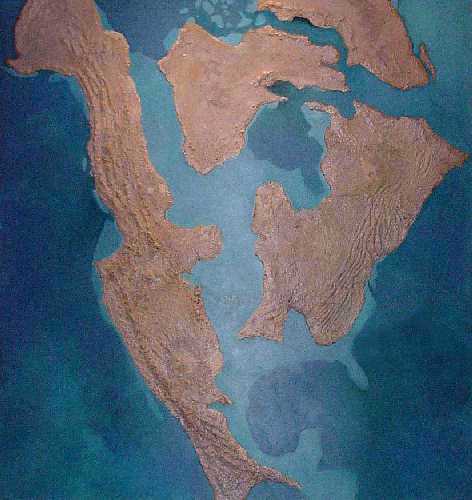 |
The Cretaceous Period
lasted from about 144 million years ago to 65 million years ago. In Kansas, it
is represented by marine and estuarine deposits from the Early Cretaceous (Albian)
Cheyenne Sandstone and Kiowa Shale that overlay the Wellington Formation (Permian)
or the Morrison Formation (Jurassic) at the base, to the Pierre Shale at the top. (See Kansas Geology Map and Time Scale).
A brief Cretaceous Time Scale is found here. The 1999
version of the GSA (Geological Society of America)
geologic time scale is found HERE
as a printable .pdf file (233 kb). A major part of the upper portion (Late Cretaceous) of these deposits is referred to as the Niobrara Formation. It contains a rather unique member called the Smoky Hill Chalk, and provides the exposures for two Kansas landmarks: Castle Rock and Monument Rocks. The chalk found in Kansas was deposited between 87 and 82 million years ago during a period when a shallow inland sea (the Western Interior Sea) covered most of the Midwest from the Gulf of Mexico to the Arctic Circle. The deposition of these chalky, marine sediments occurred during the last half of the Cretaceous Period, approximately 15-20 million years before the end of the Age of Dinosaurs. The Smoky Hill Chalk member is about 600 feet thick in Kansas, and lies conformably above the Fort Hays Limestone, and below the Pierre Shale. For the most part, the chalk is composed of the compacted shells (coccolithophores) and plates (coccoliths) of an abundant, microscopic, golden-brown algae (Chrysophyceae) that lived in the clear waters of a warm, shallow sea. A large percentage of the chalk is made up of coprolites containing coccoliths from the animals that fed on the algae. |
| A generalized map of the North American continent during late Cretaceous time. The Western Interior Sea covered most of the Midwest from the present Gulf of Mexico to the Arctic. (Map modified from an exhibit at the University of Nebraska State Museum) |
The Western Interior Sea, sometimes called the Inland Sea, was probably less than 600 feet deep in most areas, and had a relatively flat and soft, mud bottom. It is considered to be an 'epi-continental sea'; that is, one which lies on top of a continental landmass, and not between continents. Near the middle of the sea where Kansas is now located, sediments were deposited at a rate which would ultimately produce about one inch of compacted chalk for every 700 years. The chalk also has more than a hundred thin layers of bentonite clay, most of which are rusty red in color, that are the result of the fall of ash from repeated eruptions of volcanoes to the west of Kansas in what is now Nevada and Utah. These ash deposits can be traced for miles across the chalk beds and have been used as marker units in describing the stratigraphy of the formation (See Hattin, 1982). In addition, several species of vertebrate and invertebrate marine life that lived and/or became extinct at certain times during the deposition of the chalk are useful in determining the age and biostratigraphy of widely separated exposures (See Stewart, 1990). Near the end of the Cretaceous, the Western Interior Sea began to close, becoming shallower and narrower as the Rocky Mountains were pushed up from the west, uplifting the sea bottom as they rose. Eventually, the center of North America rose above sea level and the sediments (limestones, sandstones, shales and chalk) deposited on the basement rocks of Kansas for nearly half a billion years began to erode away.
 |
A map of Kansas showing the surface and sub-surface
distribution of the remaining Cretaceous rocks (adapted from the Kansas Geological Survey
Bulletin 162; 1963). Although Kansas was once nearly covered with Cretaceous marine
deposits, millions of years of erosion have removed a
large portion of them them from the surface, leaving many areas of chalk exposed along river valleys in the northwest portion of
the State. Go here for more information on Kansas Geology.
|
This shallow ocean was home to a variety of marine animals, almost all of which are now extinct. These included giant clams, rudists, crinoids, squid, ammonites, numerous sharks and bony fish, turtles, plesiosaurs, mosasaurs , Pteranodons and even several species of marine (toothed) birds. Although it seems unlikely that you would find dinosaur fossils in the middle of the Western Interior Sea, a number of them (a hadrosaur found by O. C. Marsh in 1871, and several nodosaurs, including the type specimen of Niobrarasaurus coleii) have been collected from the Smoky Hill Chalk, and their remains have been well documented. The bodies of these dinosaurs must have somehow floated hundreds of miles into the sea before sinking to the bottom or being torn apart by scavenging sharks. It is possible that they died during catastrophic flooding on the land masses to the east or west, and were carried out to sea on a large, tangled mat of trees and other vegetation (fossilized wood, including large logs, is also known from the chalk).
Over a period of about five million of years, the remains of many of these animals were preserved as fossils in the soft, chalky mud of the sea bottom. When this mud was compressed under thousands of feet overlying shale, it became a deposit of chalk that is more than 600 feet thick in Western Kansas. Most of the massive chalk formation that once covered Kansas, however, has been eroded away over the last 60 million years and is now exposed only in a relatively small area in the northwestern corner of the State. This part of Kansas is also known as the Smoky Hills.
Since 1868 and the discovery of Tylosaurus proriger, the Smoky Hill Chalk has been the source of thousands of fossil specimens, many of which are on exhibit today in museums around the world. The first significant collections of Kansas fossils were made by relatively unknown scientists like Professor Benjamin F. Mudge, Dr. George M. Sternberg, Dr. John Janeway, and Dr. Theophilus H. Turner. Many others were collected by and for such famous paleontologists as Edward Drinker Cope, O. C. Marsh, Samuel W. Williston, and Charles Sternberg, (for more information on the Sternberg family, click here), including a large portion of the Yale Peabody Museum collection that resulted from the Yale College Scientific Expeditions of the 1870s. For some 'old time' advice on collecting fossils, see an 1884 article by Charles H. Sternberg here. Much of the early work on mosasaurs in Kansas was published in The University Geological Survey of Kansas in the late 1890's. A large number have been found since then by amateur collectors and many of these have been significant additions to paleontology. The Sternberg Museum of Natural History at Fort Hays State University, the Museum of Natural History at The University of Kansas, and the University of Nebraska State Museum have excellent collections of fossils from the Smoky Hill Chalk. The Denver Museum of Nature and Science, the Sam Noble Museum of Natural History in Norman, Oklahoma, the Field Museum of Natural History in Chicago, the Philadelphia Academy of Natural Sciences, and the American Museum of Natural History also have many Kansas fossils. Click here for additional information about some early American paleontologists. For a free downloadable copy (.pdf file) of Samuel Williston's (1914) excellent book: Water Reptiles of the Past and Present, CLICK HERE.
RECOMMENDED RECENT BOOKS ON PALEONTOLOGY
 |
Oceans of Kansas is now available as a book. The book describes the animals that lived in the shallow sea covering Kansas during the Late Cretaceous and left their remains as fossils in the Smoky Hill Chalk. "A journey to a time when sea monsters roamed the middle of America" Published by the Indiana University Press, Spring 2005 |
 |
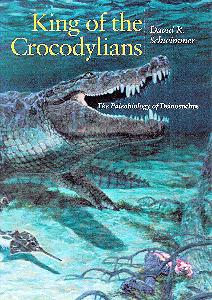 |
King of the Crocodylians The Paleobiology of Deinosuchus David R. Schwimmer Published 2002 by the Indiana University Press, 220 pages |
Released - October 2003 Sea Dragons predators of the prehistoric oceans by Richard Ellis Lawrence, KS
|
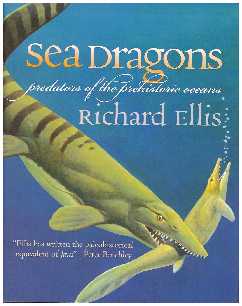 |
 |
Time Traveler In search of dinosaurs and ancient mammals from Montana to Mongolia by Michael Novacek , Curator of Paleontology, American Museum of Natural History Published by Farrar, Straus and Giroux, New York, 2002 See my review in Palaeontologia Electronica (Vol. 5, Issue 1) |
 |
Betsy Nicholls and the giant Canadian ichthyosaur Selected as a Laureate of the Ninth Rolex Awards for Enterprise Dr. Betsy Nicholls passed away October 18, 2004 after a prolonged battle with cancer |
|
 |
Mosasaurs: Last of the great marine reptiles (November 2000 - #44) Where the Elasmosaurs Roam..... (April 2002 - #53) |
Click here to go to the: Table of Contents
Click here to go to my: Paleontology Links
Click here for more information: About Mosasaurs
Click here for more information: About Oceans of Kansas Paleontology
 |
May 27, 2003 Oceans of Kansas Paleontology is one of 5 sites given a 2003 SCI-TECH Web Award in the Anthropology and Paleontology category by Scientific American |
 |
Oceans of Kansas Paleontology received a "Best of the Web" listing in the NetWatch section of Science Magazine (August 1, 2003 issue) |



